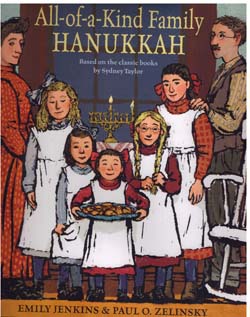All-Of-A-Kind Family Hanukkah by Emily Jenkins, illustrated by Paul O. Zelinsky; Schartz & Wade Random House Children’s Books; © 2018, ISBN 9780399-554193, 40 pages, $17.99. Publication date: September 11, 2018
By Donald H. Harrison

 SAN DIEGO – My mother Alice was born in 1912, the same year in which is set this timeless Chanukah story originated in the 1950’s by Sydney Taylor and retold today by Emily Jenkins and Paul O. Zelinsky. So, it is with an extra measure of enjoyment that I viewed Zelinsky’s illustrations of a Jewish family living in a tenement on the Lower East Side of New York City on the first night of Chanukah.
SAN DIEGO – My mother Alice was born in 1912, the same year in which is set this timeless Chanukah story originated in the 1950’s by Sydney Taylor and retold today by Emily Jenkins and Paul O. Zelinsky. So, it is with an extra measure of enjoyment that I viewed Zelinsky’s illustrations of a Jewish family living in a tenement on the Lower East Side of New York City on the first night of Chanukah.
The story, itself, could have been set in any time period, because it deals with the youngest daughter in a family of five (all of a kind) daughters, who wants to help in preparing the latkes, but is prevented from doing so by her mother who worries she might hurt herself peeling potatoes, or grating them, or cutting up onions. Frustrated that she isn’t allowed to help, 4-year-old Gertie throws a tantrum, which earns her a quick banishment to the bedroom.
She decides to hide under one of the beds, where no one can find her, but before long her father, who has a wonderful sense of humor, comes in. Pretending not to see her, he first asks the pillow, then a library book, and finally the “handkerchief hidden under the pillow and full of … gingersnaps” if they know where Gertie is – all of which is so silly that Gertie can’t help but giggle. Once her “hiding place” is given away, her father asks if she thinks she’s old enough to light the menorah, which of course she does. So, with her father’s help, Gertie performs the most symbolic Chanukah job of all – and the family happily eats together.
Historians and antique lovers will enjoy the illustrations of the mother and the girls working together in a crowded kitchen filled with old fashioned utensils. The family members wear period dresses and aprons; there is an old stove, a sink in which you can almost hear the faucet creek; and heavy iron pans in which oil for the latkes steams and spits. The bed under which Gertie hides is a period piece of inexpensive furniture. One double page spread gives an idea of what a three-room flat looked like with the kitchen, and windows in the front of the building, the girls’ windowless room in the middle, and the parents’ curtained off bedroom in the back. There is no bathroom in this picture; that probably was somewhere down the hall and was shared with neighbors.
Many Jewish families have gone on to considerable more luxury than Gertie and her sisters grew up in, and it’s nice to remember how our immigrant generation followed Jewish customs, all the while adapting to a new life in a new country.
*
Harrison is editor of San Diego Jewish World. He may be contacted via donald.harrison@sdjewishworld.com